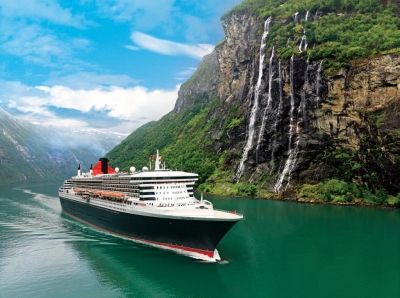
The early afternoon sun streams down on the port of Southampton as gangs of dockers start to load fresh food and supplies abroad the Queen Elizabeth 2 – the flagship of the Cunard Line and the only passenger ship to regularly cross the Atlantic. The liner docked at 1pm – and she will set out on the return voyage to New York seven hours later.
There is no time to be lost, and most of the supplies – including fruit and vegetable, tinned and frozen foods, and deep-frozen meat and fish – are carried on conveyor belts up four narrow gangways.
Meanwhile, most of the wines, spirits and soft drinks, packed into metal containers, are lifted gently abroad by crane. And 6000 gallons (27,300 litres) of draught beer are pumped straight from tankers parked at the quaysides into huge stainless-steel tanks – which are linked by pipe to the seven duty-free bars.
The food and drink will suffice for the five-day transatlantic crossing. By 7pm the supplies have been loaded; the cleaners have vacuumed the equivalent of 142 tennis courts of carpeting; the 1000 crew members are at their stations; the most of the 1800 or so passengers have arrived. They are greeted by a jazz band playing popular tunes from the latest hit shows, and are directed to their cabins by almost 80 stewards and stewardess.
Everything has been arranged for the passengers’ enjoyment and comfort – from saunas and Jacuzzis to feature films and a computer centre where they can learn ‘new skills’, such as how to operate word processors.
Each of the ten passenger decks has its own pantries (combinations of kitchens and storerooms), and these allow the stewards and stewardesses to prepare and serve anything from early morning cups of tea and coffee to elaborate late-night suppers.
Once at sea, the 14 bakers start their long working day in the three main kitchen at 5am and begin to prepare the 3000 or more rolls, croissants and Danish pastries served at breakfast. At the same time, the ship’s confectioners make the 6000 pieces of cake needed for afternoon tea and the 5000 petits fours for the evening buffet.
At 7am the first chefs arrive to prepare the ingredients for the day’s soups and stews – amounting to almost 3500 pints (2000 litres). The 75 all-male chefs – including a special kosher cook in his own kitchen – start work on the 2800 lunches and dinners as most of the passengers are finishing breakfast.
The 60 or so young cooks regularly work for up to 12 hours a day in the hot, windowless kitchens. They frequently feel homesick and tired – and occasionally some of them quit on docking at Southampton or New York. For most of them, however, it is a valuable way of gaining work experience and of seeing the world.
Hundreds of food items are kept in the storerooms, and vast meat safes stretch almost the width of the ship – 105ft (32m). Inside, the temperature of 14 (-10 ) could kill anyone trapped there for more than 12 hours. To avoid any such accident, there is an alarm bell inside each meat safe in case the doors are shut by mistake.
Farther along from the storerooms, the giant machinery is housed in the engine room – actually several enormous high-ceilinged areas, two decks deep. The nine engines themselves are each the size of a double-decker bus. They generate 130,000hp and can slow the ship down from a top speed of 32 ½ knots (60km/h) to standstill in 3 minutes and 39 seconds – over a distance of about 1 ¼ miles (2km).
The engine room also contains a water-purification plant which takes sea water on board and purifies it for drinking. The plant processes about 480 tons of water a day – enough to fill seven swimming pools the size of those on the ship. In addition, four vacuum evaporates produce 250 tons of water each day. Checking the various water tanks – which are at the very bottom of the vessel – is the responsibility of the ship’s carpenters. Some of the tanks are there to help keep the ship properly balanced; others hold the drinking water and water used for washing the laundry.
If, for any reason, more water is used from a tank on one side of the ship than on the other, the vessel will begin to list. To correct this, extra water is quickly pumped into the depleted tank.
In a small room above the engines another team of professionals – the printers – play their role in the daily life of the liner. Late each night a printed programme of the following day’s events – ranging from children’s parties to clay-pigeon shooting – is delivered to each passenger cabin. Early each morning newsletters are delivered to the cabins containing news from around the world, which is transmitted by satellite to the ship each day.
Picture Credit : Google

